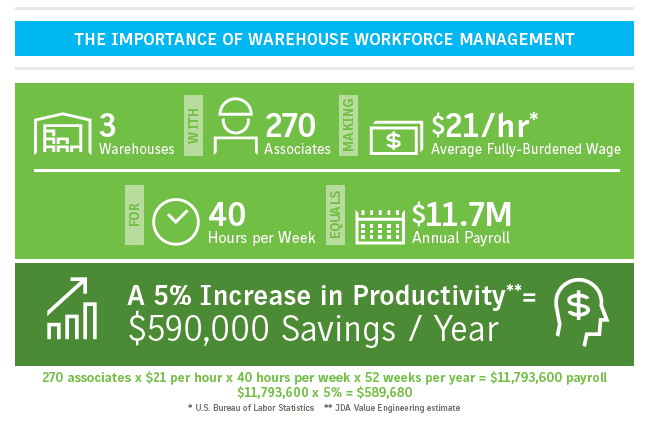
As companies strive to improve warehouse efficiency and service while cutting costs, a lot of attention is focused on the role of leading-edge technologies such as robotics, artificial intelligence and prescriptive analytics — and rightfully so. These emerging capabilities are moving companies toward achieving the vision of the Autonomous Supply Chain, which senses and responds to disruptions automatically.
But equally important are the warehouse employees who control and implement these technology solutions on a daily basis. Far from replacing human workers, advanced technologies will provide employees with increasingly strategic roles in managing warehouse results and achieving continuous service and cost improvements.
However, even as warehouse employees are becoming more important, there is a global warehouse workforce shortage that is poised to worsen between now and 2030. Caused by hyper-competition, low unemployment rates, changing demographics and other factors, this workforce crisis is forcing companies to invest in attracting and retaining the best employees. This means increasing pay rates, offering flexible scheduling and defining other quality-of-life benefits that support employee satisfaction.
Maximizing Productivity Is No Longer Optional
In this environment of reduced talent availability, coupled with increasing customer demands and service expectations, the obvious solution is not only to maintain an excellent workforce, but to maximize each employee’s productivity. As competition for labor increases, this is a competitive imperative today. Measuring and continuously improving warehouse labor productivity is no longer optional.
One of the keys to maximizing productivity lies in accurate labor scheduling — having the right number of employees in place to support service excellence during peak periods, without over-scheduling and having idle labor resources.
Fortunately, advanced workforce management tools are available to rationalize historic performance with forecasted work volumes in both the short and long terms. Site-based activity and performance metrics help create a precise picture of labor capacity and real-world outputs, enabling forward-looking scheduling needs to be defined with a high degree of confidence.
It can be difficult — if not impossible — to use manual forecasting methods to account for the asymmetrical patterns that drive real-world labor demand, including seasonality, promotions and events such as new product introductions. But, because today’s forecasting engines are supported by sophisticated algorithms, they are able to automate this process and deliver accurate schedules across different sites and seasons.
Match the Employee Profile to the Job
Advanced scheduling solutions also support the dual goals of high service and low costs by considering the skills of each warehouse employee. By creating a database of workforce skill sets and a corresponding set of warehouse tasks, technology solutions can ensure that not only are scheduling levels accurate — but that scheduled workers have the right talents for the jobs that need to be completed during each shift.
Rules-based scheduling engines can also consider other aspects of employee profiles — such as each worker’s age — to ensure compliance with local labor laws.
Employee Satisfaction: Your Hidden Advantage
Thanks to today’s advanced scheduling solutions, warehouse employees can enjoy a much higher level of satisfaction, leading to increased productivity and retention rates. The entire workforce can benefit from schedules that provide enough labor for busy periods, accommodate employees’ personal preferences and time-off requests, and streamline the entire scheduling process.
Advanced solutions for scheduling are built to meet the needs of today’s tech-friendly workforce. The accommodation of flexible scheduling requests, combined with the availability of user-friendly tools — including mobile-device interfaces — drive satisfaction, loyalty and retention. The special scheduling requirements of seasonal and temporary employees are also easily managed by workforce management solutions, reducing the need to rely on third-party temp agencies. Employees at all levels can be empowered to manage their own schedules, a cultural change that can pay high dividends in workforce satisfaction and retention.
In addition to the feeling of empowerment enjoyed by employees, scheduling administrators also have much to gain. By replacing these outdated processes with automated solutions, managers can focus on higher-value work that makes a strategic difference.
Making Continuous Improvement a Way of Life
Advanced workforce management tools provide metrics so performance can be measured and improved continuously, another significant cultural change. By offering visibility into scheduling accuracy across multiple time periods and multiple warehouse sites, these solutions enable a comparison of actual labor productivity versus expected productivity.
In addition, the leading-edge modeling and analytics provided by warehouse management solutions form the foundation for the advanced analytics and machine learning capabilities that are poised to revolutionize warehouse and workforce management in the near future.
The Financial Benefits Are Real
Many of the benefits of effective workforce management discussed here — such as increased employee satisfaction —are intangible. But leveraging the power of advanced solutions for workforce management also directly impacts the bottom line of the entire business.
Just how great are the financial benefits? JDA estimates that, for a company with three warehouses and 270 employees, improving labor productivity by just 5 percent via advanced solutions can lead to nearly $600,000 in cost savings per year.
JDA estimates that every company can save at least 3 percent of its annual labor costs simply by implementing a workforce management solution in its warehouse environment.

Summary and Closing Thoughts
In today’s hyper-competitive business environment — where customers are demanding higher levels of service at a lower cost — companies have a range of opportunities to apply advanced technology to improve their performance.
One of the most overlooked opportunities is optimizing workforce management inside warehouses and distribution centers. Yet this represents an enormous opportunity to reduce costs via increased productivity, while also continuously improving customer service levels via metrics and controls.
Maximizing workforce productivity and satisfaction in your warehouses via advanced solutions can not only drive impressive financial results, but also create a cultural environment of satisfaction and continuous improvement that position your business for ongoing leadership.
Lori Harner is Senior Director of Product Marketing at JDA.


















Leave a Reply